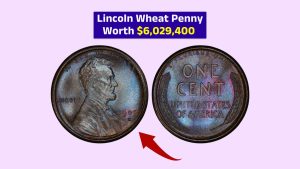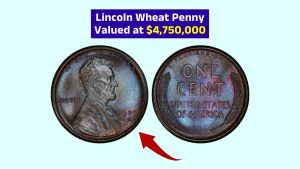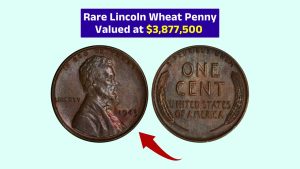The world of coin collecting is full of surprises, but few are as jaw-dropping as the story of a Lincoln Wheat Penny valued at $3,960,000 — and some believe it’s still out there in everyday circulation.
This little copper coin has sparked a wave of excitement among collectors and casual change-checkers alike, all hoping to find one of these rare treasures hiding in plain sight.
Origins
The Lincoln Wheat Penny was first minted in 1909 to honor the 100th birthday of Abraham Lincoln. Designed by Victor David Brenner, the coin features Lincoln’s bust on the front and two wheat stalks curving around the words “One Cent” on the back.
This clean and patriotic design ran until 1958, when it was replaced by the Lincoln Memorial reverse.
Rarity
So, what makes this particular penny worth nearly four million dollars? It’s all about a fascinating error during wartime. In 1943, the U.S. Mint switched from copper to zinc-coated steel for penny production to save copper for World War II. But a few leftover copper planchets from 1942 were mistakenly used.
The result was a handful of 1943 Lincoln Wheat Pennies struck in copper — a rare accident that turned into one of the most coveted coin finds in U.S. history.
Only a few of these copper 1943 pennies exist today, making them incredibly valuable. One of these rare coins recently sold for an eye-popping $3,960,000 in a private sale.
Here’s a quick reference:
| Coin Type | Estimated Value |
|---|---|
| 1943 Copper Penny | Up to $3,960,000 |
| 1909-S VDB | $700 to $2,000+ |
| 1914-D | $300 to $3,000+ |
| 1922 No D | $500 to $6,000+ |
Circulation
It may sound unbelievable, but some experts think one or two of these ultra-rare pennies might still be sitting in someone’s coin jar or hiding in a cash register.
Because they look so much like normal pennies — especially when worn down — they can easily slip by unnoticed. That’s part of the charm and mystery that keeps collectors on their toes.
Imagine casually dumping your change into a coin-counting machine, not knowing one of the pennies could cover the cost of a luxury home.
Identification
If you think you’ve got a special penny, here’s how to check:
- Date and Material: Look for the year “1943” on the coin. If it’s made of copper, it’s rare.
- Magnet Test: Steel pennies stick to a magnet. Copper ones don’t.
- Weight: A copper penny from 1943 should weigh about 3.11 grams. A steel one weighs less, around 2.7 grams.
- Color: Copper has a reddish tone, while steel looks more grey or silver.
If your 1943 penny passes these tests, don’t rush to cash it in. Instead, have it authenticated by a professional coin grading service like PCGS or NGC.
Buzz
Why does this penny continue to capture imaginations? For one, it ties into a sense of American heritage — a small coin that lived through World War II and still holds its value generations later.
And of course, the idea that a multimillion-dollar treasure might be sitting in your junk drawer is just too good to ignore.
It’s that rare intersection of history, mystery, and luck that makes coin collecting so addictive. In a world moving rapidly toward digital transactions, finding a hidden gem in spare change feels like discovering buried treasure.
The legend of the Lincoln Wheat Penny worth $3,960,000 shows no signs of fading. Whether you’re a seasoned collector or someone who just picked up a penny off the ground, the thrill of possibly owning a rare piece of history is very real.
So next time you get change back at the store, take a second look — you never know what you might find.
FAQs
Why is the 1943 copper penny rare?
It was an accidental minting using leftover copper planchets.
How many 1943 copper pennies exist?
Only a few dozen are known to exist today.
How can I test a 1943 penny?
Use a magnet and scale; copper doesn’t stick and weighs 3.11g.
Can I still find rare pennies in change?
Yes, rare coins have been found in circulation before.
Who designed the Lincoln Wheat Penny?
Victor David Brenner designed it in 1909.



